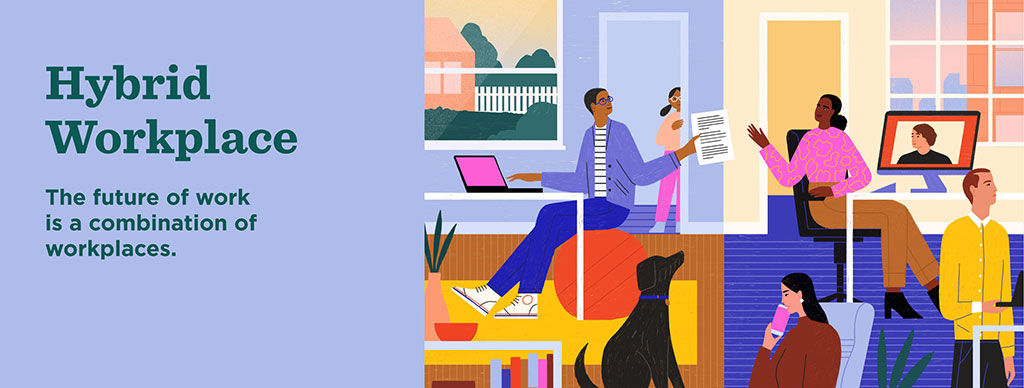

“The future ain’t what it used to be.”
~ Yogi Berra
No it ain’t. And the last two years was certainly not what we were expecting them to be. We all know how drastically things changed in February/March of 2020:
The pandemic forced most businesses to adopt a new way of doing their work and getting their products or services to the end customer. This process had to happen in a heartbeat as the lockdowns of March 2020 occurred. Now it’s time to go beyond that to the ‘New Normal.’
Enterprise was forced to find out if their business could remain productive with at least mostly empty offices. When you consider that it was not that many years ago that working from home was a rare situation, the quantum leap to nearly everybody working remotely was a splash of cold water in the face, and it was worrisome.
After the initial dust had settled, many companies, including Microsoft reported an increase in worker productivity, BUT – as time went by, that increase leveled off, and in many areas even decreased. The reason most cited was that the adverse effects of isolation and lack of social interaction with coworkers eventually took a toll on employees.
A 2021 survey of more than 61,000 Microsoft workers published in the journal Nature Human Behaviour, it was cited that the most common ill-effect was on the quality of company collaboration, causing business groups within Microsoft to become less interconnected, with many of the smaller but necessary voices within these collaborative groups to be excluded as inconvenient, producing a more stagnant pool of fresh ideas.
Microsoft produces products, but they are in essence an information company
IT Support LA needed certain personnel to be mobile during the pandemic - specifically, our team of field technicians - as did any Managed IT services providers. Even if the office was completely empty, the onsite servers and networking gear must be attended to. We had temporarily set up our in-house IT Help Desk Support team at home, and it worked better than we expected. With the automated processes and AI (Artificial Intelligence we employ, our technicians can remote into a network to perform maintenance and repairs from their smart phones. It is cumbersome, but doable.
Within a couple of weeks, our remote techs were back in the office, making for faster responses and faster repairs. The social interaction also helps with the occasional ‘odd’ IT support issue they encounter – it’s very handy to ask a co-worker, “Hey, have you ever seen something like this?” However, in the same respect, it’s also easy for them to waste time talking about sports or movies.
Having discussed these changes with colleagues in the IT Support Los Angeles Community, most went through the same type of transition in. Many of the small IT support companies did not have an operation that had the sophistication to allow for full home-based IT Help Desk Support, but more than a few of the solo practice IT service ‘Guys’ were probably part of the ‘work from home’ crowd already.
A lot of shoddy IT support was uncovered in the mad rush to a remote workforce. We know this to be the case because after the initial scramble to set up thousands of employees all over the Southland to be able to work from home, we became the beneficiary of some ‘competitors’ incompetent work – having come to the rescue as problems flourished.
The worldwide transition to a remote workforce also provided a feeding ground for cyber-criminals. If IT consulting services did not set up remote networks properly, vulnerabilities in both reliability and security become apparent to those who are looking for them – namely cyber crooks. It was like blood in the water for these cyber-sharks. We were more than happy to take on new clients when this below-par work caused problems.
What now?
Is COVID really winding down? All the indications are there, so the questions that business have been discussing is once again rising to the forefront: Where do we go from here? How will our workforce operate on a permanent basis?
There are basically three options:
1) Bring everybody back to the office.
The statistics showing workers’ attitudes on returning to the office (at the end of 2020, 92% said they would seek other employment if required to return) fluctuate monthly, although the trend is that resistance is decreasing.
2) Let everyone stay home.
Still the most popular option among remote workers.
3) Do both: the Hybrid Work model
Some days at home, some in the office. This is becoming an increasing popular idea with time, as many workers miss the office interaction but do not want it full time. Choosing the type of hybrid which works best for any company is key to the success of the new work environment.
What are the different types of hybrid work models?
There are 5 basic models which support a wide range of specifics as to scheduling:
1) At-Will/Remote-First Model
Employees choose where to work: the amount of time spent in either environment is up to them. Does not typically have a requirement, but remote work is prevalent.
2) Office-First Model
Similar to At-Will/Remote-First, but there is usually a requirement that more time is spent in the office.
3) Split-Week Model
Times and locations of work are assigned by management, for example, Monday/Tuesday in-office, the remainder of the week at home.
4) Week-By-Week Model
One week in-office, next week at home, for example.
5) Designated Teams Hybrid Work Model
Set up by management and determined by the collaborative nature of various teams – some need to be physically together and some do not.
Regardless of the model your company chooses, it is important to make the best use of your resources going forward. Gauge the upsides and downsides based on your experience over the last two years.
Frequently Asked Questions
Q: Does hybrid work really work?
A: Overall, it seems to. Accenture published a report that says 83% of employees favor a hybrid work model that allows them to work from home between 25% and 75% of the time.
Q: What is the best way to support remote employees?
A: Essentially, a company should mirror the practices that were in effect before the pandemic – with innovative ways to adapt to the remote workforce. Forbes offers an effective overview of the ‘15 Ways To Better Support Remote Employees’
Q: What are best practices when working remotely?
A: The best are the same as in the office: Effective communication and technology, separation of business versus personal time, avoiding distractions etc. Quantum Workspace lays out 43 Best Practices, which apply to both management and employees.
Q: What is a hybrid work schedule?
A: In effect, it is whatever combination of balance of office/home work that management and employees find acceptable and effective.
Is your remote network secure?
IT Support LA offers a FREE, no-risk network and security assessment to all companies in the Greater Los Angeles area with a minimum of 10 computers and 1 server. No strings, no obligation.
Just fill out the form on this page or call us at:
818-805-0909


